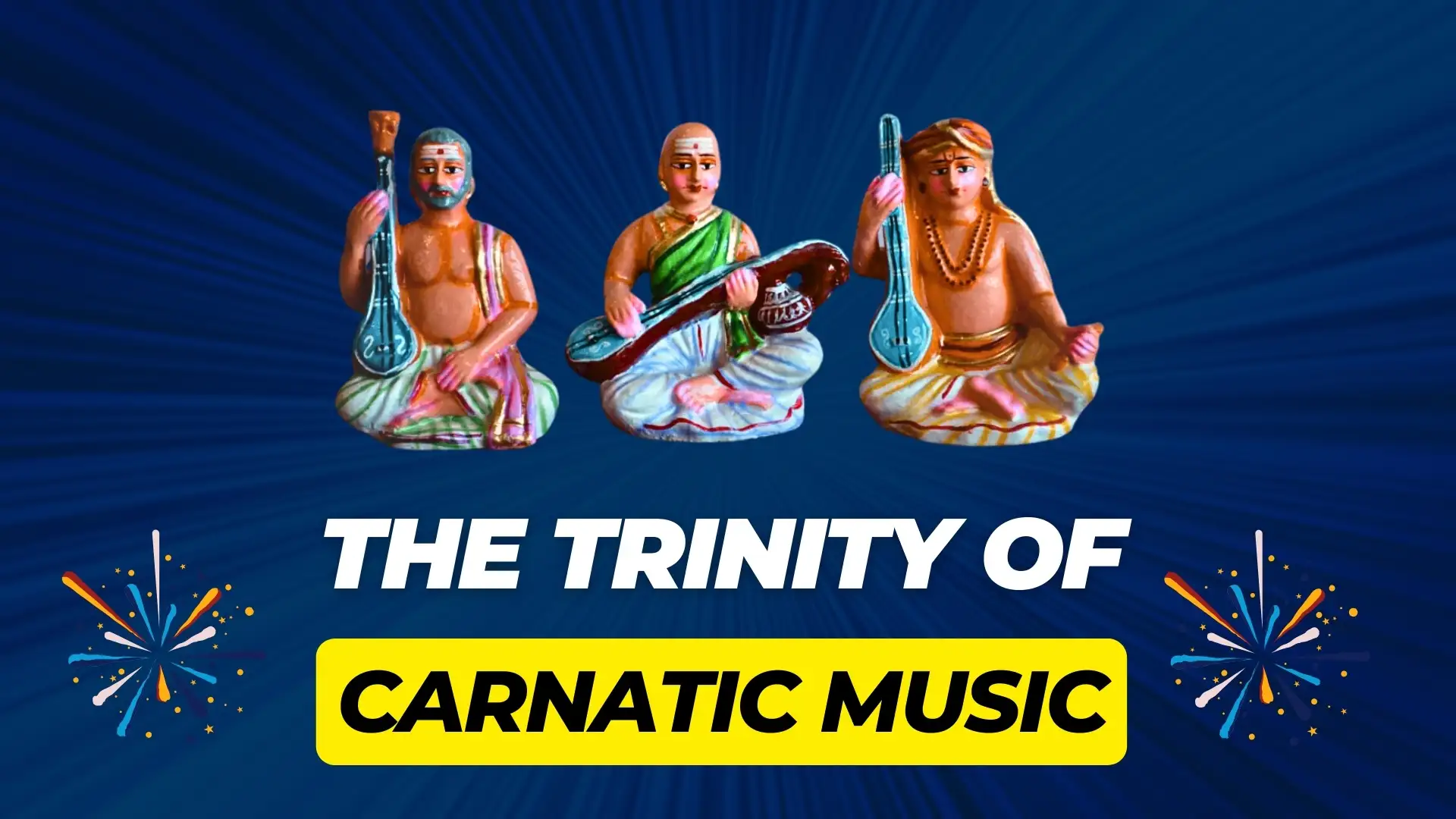Carnatic music, often considered a form of art owes its greatness to three composers who have laid the foundation for its rich heritage. The Carnatic Music Trinity, comprising of Tyagaraja, Muthuswami Dikshitar and Syama Sastri holds a significance in the realm of Indian music. This blog explores the history, influences and lasting impact of these maestros on musicians and enthusiasts.

The Trinity of Carnatic Music, Thyagaraja, Muthuswami Dikshitar and Shyama Shastri are more than composers. They hold a timeless mastery, over creating enchanting melodies that serve as the foundation of tradition and are the originators of a symphony that goes beyond time and touches the depths of our souls.
Carnatic Music Trinity: A Historical Perspective
Understanding the roots and invaluable contributions of the trinity composers is crucial to comprehending the journey of music. These musical luminaries were born in the century during a period when India’s cultural landscape was undergoing transformation. Their compositions serve as a bridge between tradition and innovation by infusing elements into rooted traditions.
The profound influence that the trinity has had on shaping music is evident in their repertoire of compositions. Each composer brings forth their style and preferences collectively establishing the melodic and rhythmic framework that defines this genre even today.
Influence of the Carnatic Music Trinity
The influence of the Carnatic Music Trinity can be truly understood when we explore the repertoire they have created. Tyagaraja’s compositions, known for their emotions and spiritual fervor, deeply resonate with audiences. Provide a glimpse into the composer’s devout nature.
On the other hand Muthuswami Dikshitars kritis showcase a mastery of intricate raga structures reflecting a harmonious blend of tradition and innovation. Syama Sastri compositions, renowned for their appeal often feature rhythmic patterns.
Beyond their creations the Trinity has significantly shaped the pedagogy of music. Students and practitioners alike draw inspiration from their works to gain insight into the nuances of raga ( framework) , tala ( cycle) and bhava (emotional expression).
Impact of the Carnatic Music Trinity on Musicians today
As we journey through time it becomes evident that the impact of the Carnatic Music Trinity extends across generations. Contemporary musicians find inspiration in Tyagarajas marvels Muthuswami Dikshitars woven ragas and Syama Sastris emotive compositions.
The legacy of the Trinity is not confined to concerts; their compositions have transcended boundaries and found expression in diverse genres such as fusion, devotional music and even experimental genres.
The timeless creations of these composers have the power to resonate with audiences, from musical backgrounds highlighting the universal appeal of their music.
Trinity of Carnatic Composers: A Melodic Influence in Every Note
The impact of the Trinity extends beyond concert halls; it deeply touches the hearts of musicians who carry forward the tradition of Carnatic music. Tyagaraja, Muthuswami Dikshitar and Syama Sastri are not just revered as composers. As cultural icons whose contributions have shaped the very essence of Indian classical music.
Did You Know?
Trinity of Carnatic Music consists of three composers who played a role, in shaping and standardizing the classical music tradition of South India? During the 19th centuries Tyagaraja, Muthuswami Dikshitar and Syama Sastri made contributions to Carnatic music.
Conclusion
In summary the Trinity’s mesmerizing compositions and profound influence stand as a testament to the beauty and timelessness of this art form. As we continue to explore and appreciate their legacy their melodies echo through the corridors of music seamlessly connecting past and present, in a harmonious celebration of artistic brilliance.
FAQs
Who are the three composers, in music?
The Carnatic music trinity is comprised of Tyagaraja, Muthuswami Dikshitar and Syama Sastri.
Why are they known as the trinity?
They earned the title of trinity due to their contributions and profound impact on music.
During which period did they live?
They lived during the 19th centuries.
What makes them significant in the history of music?
Their significance lies in shaping the foundations of music and enriching its repertoire.
How did they influence each others work?
Their influence on one another was shaped through interactions exchanging ideas and holding mutual admiration.
What are some compositions by Tyagaraja, Muthuswami Dikshitar and Syama Sastri?
Known compositions include Tyagarajas “Pancharatna Kritis ” Muthuswami Dikshitars “Kritis,” and Syama Sastri “Varnams.”
What are the similarities and differences, in their styles?
Similarities can be found in their exploration of ragas while differences arise in themes and musical structures.
How did the musical creations of Tyagaraja, Muthuswami Dikshitar and Syama Sastri influence one another?
They influenced each other by incorporating elements exploring thematic variations and innovatively utilizing ragas in their compositions.
Related Blog: Himagiri Thanaye






























